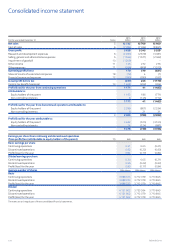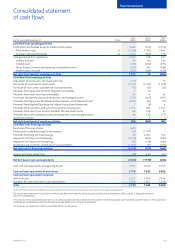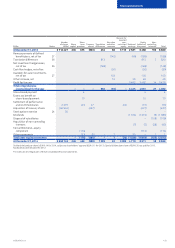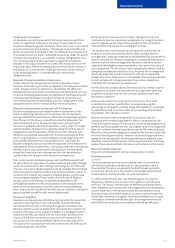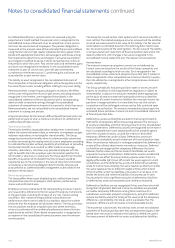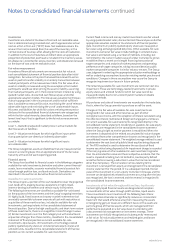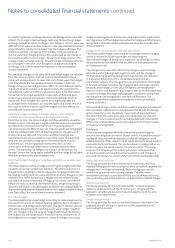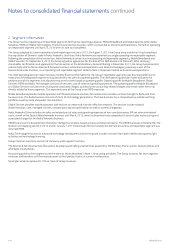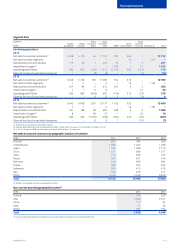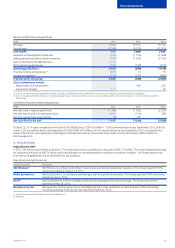Nokia 2014 Annual Report Download - page 135
Download and view the complete annual report
Please find page 135 of the 2014 Nokia annual report below. You can navigate through the pages in the report by either clicking on the pages listed below, or by using the keyword search tool below to find specific information within the annual report.
133
Financial statements
NOKIA IN 2014
Foreign currency translation
Functional and presentation currency
The nancial statements of all Group entities are measured using
functional currency, the currency of the primary economic
environment in which the entity operates. The consolidated nancial
statements are presented in euro, the functional and presentation
currency of the parent.
Transactions in foreign currencies
Transactions in foreign currencies are recorded at exchange rates
prevailing at the dates of the individual transactions. For practical
reasons, a rate that approximates the actual rate at the date of the
transaction is often used. At the end of the accounting period, the
unsettled balances on foreign currency monetary assets and liabilities
are valued at the exchange rates prevailing at the end of the
accounting period. Foreign exchange gains and losses arising from
statement of nancial position items and fair value changes of related
hedging instruments are recognized in nancial income and expenses.
Unrealized foreign exchange gains and losses related to non-current
available-for-sale investments, such as equity investments, are
recognized in other comprehensive income.
Foreign Group companies
All income and expenses of foreign Group companies where the
functional currency is not euro are translated into euro at the average
foreign exchange rates for the accounting period. All assets and
liabilities of foreign Group companies are translated into euro at
foreign exchange rates prevailing at the end of the accounting period.
Dierences resulting from the translation of income and expenses at
the average rate and assets and liabilities at the closing rate are
recognized as translation dierences in other comprehensive income.
On the disposal of all or part of a foreign Group company through
sale, liquidation, repayment of share capital or abandonment, the
cumulative amount or proportionate share of translation dierences
is recognized as income or expense when the gain or loss on disposal
is recognized.
Foreign Group companies in hyperinationary economies
The nancial statements of foreign Group companies where the
functional currency is the currency of a hyperinationary economy
areadjusted to reect changes in general purchasing power.
Non-monetary items in the statement of nancial position and all
items in the income statement are restated to the current purchasing
power by applying the general price index and translated into euro
using the measuring unit current at the end of the accounting period.
Inationary gains and losses on the net monetary position are
recognized as gains and losses in the consolidated income statement.
Comparatives presented as current year amounts in the prior year
nancial statements in a stable currency are not restated.
Assessment of the recoverability of long-lived assets, intangible
assets and goodwill
The Group assesses the carrying value of goodwill annually or more
frequently if events or changes in circumstances indicate that such
carrying value may not be recoverable. The carrying value of
identiable intangible assets and long-lived assets is assessed if
events or changes in circumstances indicate that such carrying value
may not be recoverable. Factors that trigger an impairment review
include, but are not limited to, underperformance relative to historical
or projected future results, signicant changes in the manner of the
use of the acquired assets or the strategy for the overall business,
and signicant negative industry or economic trends.
For purposes of impairment testing, goodwill has been allocated
to the cash-generating units or groups of cash-generating units
(“CGUs”) expected to benet from the synergies of the combination.
A cash-generating unit, as determined for the purposes of the Group’s
goodwill impairment testing, is the smallest group of assets, including
goodwill, generating cash inows that are largely independent of the
cash inows from other assets or groups of assets.
The Group conducts its impairment testing by determining the
recoverable amount for the asset or cash-generating unit. The
recoverable amount of an asset or a cash-generating unit is the
higher of its fair value less costs of disposal and its value-in-use.
The recoverable amount is compared with the asset or
cash-generating unit’s carrying value. The carrying value of a
cash-generating unit’s net assets is determined by allocating relevant
net assets to cash-generating units on a reasonable and consistent
basis. An impairment loss is recognized immediately in the
consolidated income statement if the recoverable amount for an
asset or a cash-generating unit is less than its carrying value.
Other intangible assets
Acquired patents, trademarks, licenses, software licenses for internal
use, customer relationships and developed technology are capitalized
and amortized using the straight-line method over their useful lives,
generally three to seven years. When an indication of impairment
exists, the carrying amount of the related intangible asset is assessed
for recoverability. Any resulting impairment losses are recognized
immediately in the consolidated income statement.
Property, plant and equipment
Property, plant and equipment are stated at cost less accumulated
depreciation. Depreciation is recorded on a straight-line basis over the
expected useful lives of the assets as follows:
Buildings and constructions
Buildings and constructions 20—33 years
Light buildings and constructions 3—20 years
Machinery and equipment
Production machinery, measuring
and test equipment 1—5 years
Other machinery and equipment 3—10 years
Land and water areas are not depreciated. Assets held for sale are not
depreciated as they are carried at the lower of carrying value and fair
value less costs to sell.
Maintenance, repairs and renewals are generally expensed in the
period in which they are incurred. However, major renovations are
capitalized and included in the carrying amount of the asset when it
is probable that future economic benets in excess of the originally
assessed standard of performance of the existing asset will ow to the
Group. Major renovations are depreciated over the remaining useful
life of the related asset. Leasehold improvements are depreciated
over the shorter of the lease term and the useful life. Gains and losses
on the disposal of property, plant and equipment are included in
operating prot or loss.
Leases
The Group has entered into various operating lease contracts. The
related payments are treated as rental expenses and recognized in the
consolidated income statement on a straight-line basis over the lease
terms unless another systematic approach is more representative of
the pattern of the Group’s benet.



